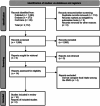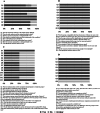Food Intake According to Clock Gene Polymorphisms: A Systematic Review
- PMID: 40787788
- PMCID: PMC12337243
- DOI: 10.1096/fj.202500951R
Food Intake According to Clock Gene Polymorphisms: A Systematic Review
Abstract
This systematic review investigated differences in daily energy intake among genotypes of circadian clock genes, potentially supporting personalized nutritional strategies for health. This topic can help develop personalized nutritional strategies for metabolic health by evaluating SNPs in circadian clock genes that may influence dietary intake. We searched the PubMed, EMBASE, and Cochrane Library databases following PRISMA guidelines and assessed the risk of bias using the Joanna Briggs Institute (JBI) tool (PROSPERO: CRD42024601530). Ten studies were included, involving 12,115 adult and elderly participants (mean age 40.8 ± 8.6 years; 60.6% women). Six studies investigated the SNP CLOCK rs1801260, while four analyzed the SNPs CLOCK rs4580704, CLOCK rs3749474, CRY1 rs2287161, and CRY2 rs11605924, with one study for each. Only one study found an association between the minor allele of CLOCK rs1801260 and increased energy, carbohydrate, and lipid intake, as well as later meal timing. Individuals with at least one risk allele (C) had higher intake and later mealtimes than those with the wild-type allele (TT). The inconsistent associations across studies may be attributed to methodological limitations, including dietary assessment, sample size, genetic model classification, population characteristics, and environmental factors, such as including dietary patterns, chronotype, night shift work, sleep, and meal timing. Future research should adopt more comprehensive approaches to better clarify the impact of circadian gene variants on eating behavior.
Keywords: circadian clocks; energy intake; genotype; mealtimes; single nucleotide polymorphism.
© 2025 The Author(s). The FASEB Journal published by Wiley Periodicals LLC on behalf of Federation of American Societies for Experimental Biology.
Conflict of interest statement
The authors declare no conflicts of interest.
Figures



Similar articles
-
Later eating timing in relation to an individual internal clock is associated with lower insulin sensitivity and affected by genetic factors.EBioMedicine. 2025 Jun;116:105737. doi: 10.1016/j.ebiom.2025.105737. Epub 2025 Apr 29. EBioMedicine. 2025. PMID: 40305967 Free PMC article. Clinical Trial.
-
Nutritional interventions for survivors of childhood cancer.Cochrane Database Syst Rev. 2016 Aug 22;2016(8):CD009678. doi: 10.1002/14651858.CD009678.pub2. Cochrane Database Syst Rev. 2016. PMID: 27545902 Free PMC article.
-
Oral nutritional interventions in frail older people who are malnourished or at risk of malnutrition: a systematic review.Health Technol Assess. 2022 Dec;26(51):1-112. doi: 10.3310/CCQF1608. Health Technol Assess. 2022. PMID: 36541454 Free PMC article.
-
Polymorphisms in MTNR1A (rs2119882) and CLOCK (rs1801260) genes are associated with facial acne susceptibility in gas station workers.PLoS One. 2025 Jul 24;20(7):e0329150. doi: 10.1371/journal.pone.0329150. eCollection 2025. PLoS One. 2025. PMID: 40705802 Free PMC article.
-
Dietary interventions for recurrent abdominal pain in childhood.Cochrane Database Syst Rev. 2017 Mar 23;3(3):CD010972. doi: 10.1002/14651858.CD010972.pub2. Cochrane Database Syst Rev. 2017. PMID: 28334433 Free PMC article.
References
Publication types
MeSH terms
Substances
Grants and funding
LinkOut - more resources
Full Text Sources

